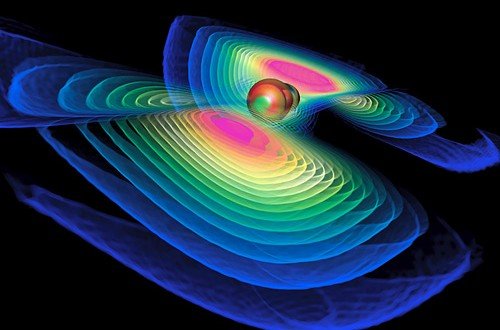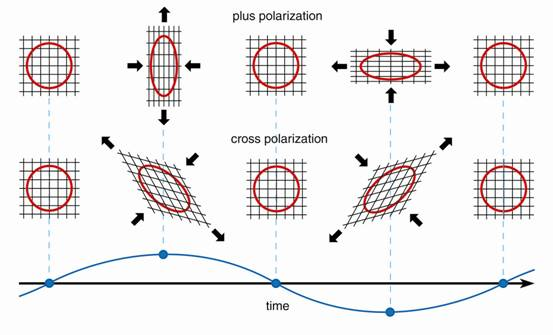Energy in Gravitational Waves
Welcome back to some further musings on gravitational waves! Hopefully you read yesterday's introductory post, if not you can find it here. In this follow up post, we will consider the energy in gravitational waves, but, before we attack this concept, we will first tie up a loose end from last time, on the polarisations of gravitational waves.

Two Polarisations
The general solution of a gravitational wave propagating in the z direction is given by

where both h_+ and h_x are arbitrary functions of (t-z).
Gravitational waves are deformations of space itself, that stretch it first in one direction, then in the perpendicular direction. This is demonstrated in the figure below.

Energy in Gravitational Waves
The energy density in Newtonian gravity is given by

We must be careful, though, if we try to generalise this by replacing the gradient of the scalar field by derivaties of the metric. Physical quantities in general relativity cannot be dependent upon the coordinate choice. In fact, we often choose coordinates where stuff vanishes to make life a bit easier!
Unlike in Netwonian theory, the idea of local energy in a gravitational field is not a valid one. This represents a profound shift in viewpoint from gravity as a force field acting in spacetime, to gravity as spacetime.
Now, we are able to associate energy to entire spacetime, when it is asympotically flat, such as in the case of black hole masses. We can generate a rough expression for the energy in gravitational waves, when the wavelength is much smaller than the degree of curvature of the spacetime. This energy is an average energy density over spacetime volumes; the dimensions of which are larger than the wavelength, but much smaller than the background curvature scale.
Lets consider the waveform

We now make the simplifying assumption that energy density is proportional to the amplitude squared, and note that the units of energy density are M/LT^2. The only way to obtain these dimensions is with an expression

It turns out that the energy density of gravitational waves is given by

Now, we know they travel at speed, c, therefore we can write the energy flux as

That's all for today, folks, thanks for reading! In the next post on gravitational waves, we will approach the problem a little more rigorously, by considering the linearised Einstein field equation with sources.
Well written. Thanks for bringing more science to this platform.
My pleasure, hope you enjoyed.
An amazing read, thank you for sharing!
Thanks for reading!